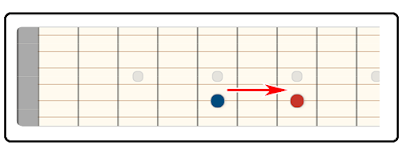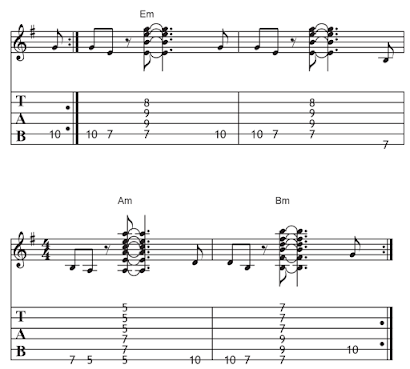1 Simple Technique ANY Guitarist Can Learn in 1 Minute!
One of the problems that guitar players face when trying to connect chords is the understanding for how to begin adding in a few simple, (but well connected), bass lines.
Most guitarists will often refer to these "connecting lines," as those "bass-line filler notes played from one chord to the next." But, regardless of what you call them, adding in a few well placed passing notes (from one chord to another), is still quite a challenge for most guitar players.
A commonly overlooked aspect of doing this work, is that if all you're going to do is play crossover notes between chords, the method that you apply doesn't need to be very complex.
In this video I'm going to show you the perfect way to add filler notes from one chord to the next. This approach is going to develop an easy and fast way to effectively organize bass tones between chords.
GOT 1 MINUTE TO LEARN A GREAT IDEA?:
In this lesson were going to talk about a quick and easy idea that will only require a minute (or less), to integrate into your guitar playing. It’s so easy to do and it sounds so good that you’ll take the principle of how this works into almost every playing situation from here on out.
This idea is generally referred to as “Approach from Above / Approach from Below.” And, it has to do with using either an interval (or a couple of intervals), played either below or above the root note of chords found in a progression.
I know this sounds easy (and it really is), but like all guitar techniques there are a couple of things to keep in mind when you apply it. So, be sure to stick with me til the very end of the video so that you can learn all of the specific details about exactly how this idea works.
GETTING STARTED:
In getting started, let’s learn how this “Approach from Above / Approach from Below,” principle operates on the fingerboard with a quick demonstration of the technique in action.
We’ll set ourselves up in the key of “E Minor,” using a couple of Barre Chords built from the 5th and 6th string root. Here’s our first example, based upon the idea of, “Approach from Below.”
Example 1). “Approach from Below”
Using approach from below tones are the easiest to integrate because they are the tones that are found from a whole step under the Root of each Minor chord, or generally a half-step (1 fret) under Major chords.
fig. 1:
Approach from below (5th string)
the red dot is the root, with the blue dot functioning as the "below" note
fig. 2:
Approach from below (6th string)
this principle can be applied anywhere on any string
The procedure is really easy to apply in Minor chord situations because all you have to do is play the note that’s 2-frets under the root of each Minor chord in your progression to build a really slick sounding ‘approach effect’ for each chord in your minor chord jam.
Learn the Progression Below:
MAJOR CHORDS:
Major key chords are just as easily covered by playing a ½ step (1 fret) under the Major Root chord and the IV chord but, you’ll need to keep in mind that the V chord of the key will need to be approached by way of 2 frets instead of 1.
So, coming up next, I’m going to cover how to play the opposite idea of this concept, called, “Approach from Above.” But first - here’s a quick promotional message about my popular, “Handouts Collection” eBook offer…
I wanted to take a minute to let you know, that if you want to learn even more about scales and theory I have a great offer for you.
With any donation over $5, or any merchandise purchase from my Tee-Spring store, I’ll send you free copies of THREE of my most popular digital handouts.
One is called, “Harmonized Arpeggio Drills” (it’ll train you on developing your diatonic arpeggios).
Another one is my “Barre Chord” Handout which includes a page showing all the key signatures along with a chord progression that applies barre chords.
Plus, you’ll get my Notation Pack! It has 8 pages of important guitar worksheets for notating anything related to; music charts, guitar chord diagrams, and TAB.
As a BONUS, (from my "Over 40 and Still Can't Play a Scale" video), I'll also throw in a breakdown of all of the chords that are diatonic to the "F Major" scale.
As an EXTRA BONUS for my Phrygian Dominant video, I'll also throw in a breakdown featuring all of the chords that are diatonic to the Phrygian Dominant scale.
Just send me an email off of the contact page of CreativeGuitarStudio.com to let me know about either your donation or your Merchandise purchase and I’ll email you those digital handouts within 24 hrs.
____________________________________________________
Example 2). “Approach from Above”
When we integrate this idea from the opposite direction called the, “Approach from Above,” we can work this phrasing idea around our chords by coming into the root of each chord through its most appropriate color tone.
This next example I have for you, is still in the key of “E Minor.”
Approach from Above: key of, “E Minor”:
Perhaps you noticed in my example play through that I didn’t stick with only color tones of a Minor 3rd interval above each chord. Instead, in this example, I took a different direction on the IV-chord of “A Minor” by playing above that chord by way of a whole step (of 2 frets).
The Minor 3rd, (shown in fig. 3 below), works perfect for the approach from above technique.
fig. 3:
Minor 3rd w/ approach from above (5th string)
this principle can be applied anywhere on any string
fig. 4:
Minor 3rd w/ approach from above (6th string)
this principle can be applied anywhere on any string
See, this is always something to consider as you start messing around with the “Approach from Above and Below Concept.” Once you begin getting better at doing this, you can develop other ways of approaching each chord in your progression. Like in this case I approached the “E Minor” from a Minor 3rd, as well as the V-chord of “B Minor,” in the same way.
But, I changed the approach on that “IV-chord” of “A Minor” by using a 2-fret approach.
fig. 5:
Whole-Step approach from above (6th string)
this principle can be applied anywhere on any string
As your playing skills improve you can experiment with additional ideas as well. Here’s an example (the video clip below), of doing this technique with several options in play…
CONCLUSION:
The main thing to keep in mind with this technique is that it has very few limitations. And, it can be approached in quite a flexible way musically, because you have choice through the different chord changes in how you’ll be playing the groove of the beat, and how the different qualities of each chord, (by quality I mean whether the chord is; Major, Minor, or perhaps Dominant 7).
Along with all of that, there’s some flexibility with what step of harmony that a guitarist can decide on. You probably noticed in my examples that I changed the interval distance at times (based upon whether I was on the Root chord, or the 4th or on the 5th degree chord of the key’s harmony).
You don’t really need to comprehend all of the music theory, because this approach is pretty much anchored in the principle of; “If it sounds good, use it, and if it sounds bad, Don’t Use It.”
All in all this simple technique is a fun and easy concept that will offer you a lot of cool phrasing in almost all of your chord progressions!














